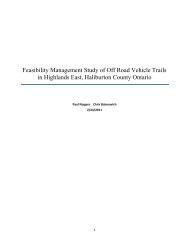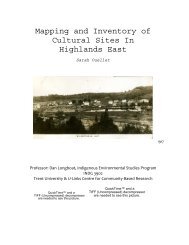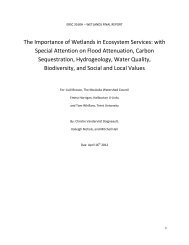Untitled - Haliburton County Community Cooperative Inc
Untitled - Haliburton County Community Cooperative Inc
Untitled - Haliburton County Community Cooperative Inc
- No tags were found...
You also want an ePaper? Increase the reach of your titles
YUMPU automatically turns print PDFs into web optimized ePapers that Google loves.
someone up to $15,000 for a few square metres of dredging. This shows that the importance ofshoreline habitats is recognized in the township.The Department of Oceans and Fisheries has a no net loss policy in place for shorelinedevelopment as well that Muskoka Region developments must follow (Brown, 1998). There is however alack of precedent for habitat replacement on Ontario shorelines. An estimated 80% of the Great Lakesshoreline is privately owned and more than 40% of the Canadian shoreline is covered by developmentfrom commercial, industrial, and residential sectors, and more than 17 % by agricultural means(Lawrence, 1995). Less 32% remains “natural” or forested shorelines on Canadian sides (Lawrence,1995). With well over 50% of shorelines being developed in the Great Lakes it is impossible forreestablishment of an equivalent amount.Several papers have been written exemplifying the detriments of shoreline development on fishhabitats. Paul Keddy produced a paper with particular relevance to the Muskoka Region. His work wascompleted on Axe Lake, near Parry Sound, ON. The study focused on different levels of shore disruptionand the effect of the exposure limits of the biodiversity it effects. Keddy’s work incorporated looking ataquatic plant biodiversity, and the biodiversity of small foraging fish that inhabit those plants (includingthose that are prey to targeted game species). By studying sections of shoreline with different exposuregradients Keddy was able to produce different biodiversity scores for different levels of shorelinevegetation and natural cover. Species richness was found at its lowest in areas of highest shorelineexposure (Keddy, 1983). Species richness was found to highest in areas of ‘intermediate’ or most naturallevels of exposure (Keddy, 1983). Keddy’s finding support the notion that upholding pristine shorelines,and minimizing development will help sustain healthy waters and fish habitats.A study on Lake Iowa showed similar results, when studying shoreline development effect onabundance and diversity of juvenile fish and fish larvae. Information was gathered along the shoreline ofLake Iowa comparing areas of development (cottages, docks, boathouse etc.) and areas in a natural25







